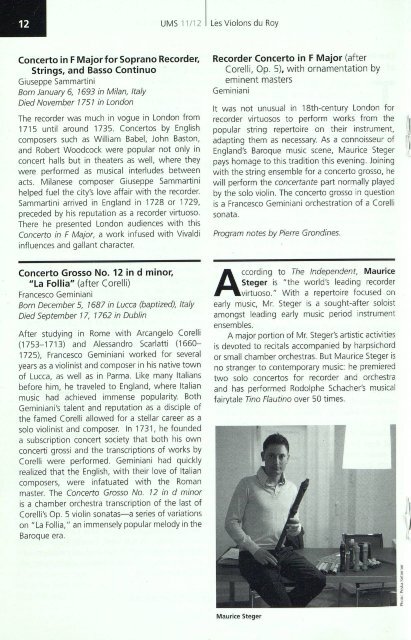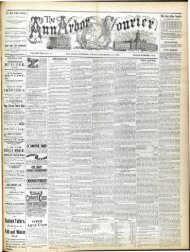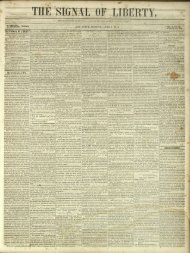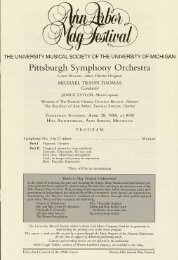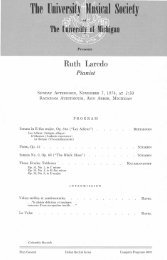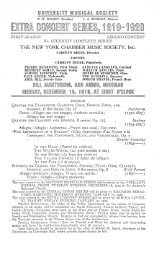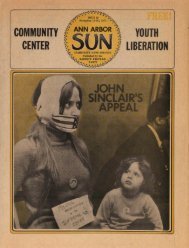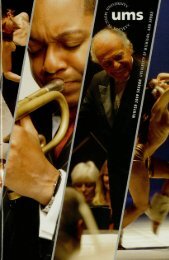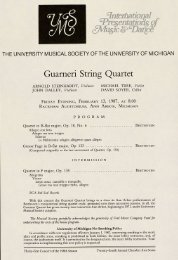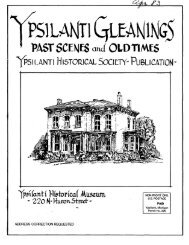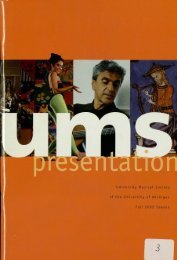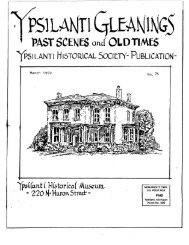University Musical Society - Ann Arbor District Library
University Musical Society - Ann Arbor District Library
University Musical Society - Ann Arbor District Library
You also want an ePaper? Increase the reach of your titles
YUMPU automatically turns print PDFs into web optimized ePapers that Google loves.
Concerto in F Major for Soprano Recorder,<br />
Strings, and Basso Continue<br />
Giuseppe Sammartini<br />
Born January 6, 7 693 in Milan, Italy<br />
Died November 1751 in London<br />
The recorder was much in vogue in London from<br />
1715 until around 1735. Concertos by English<br />
composers such as William Babel, John Baston,<br />
and Robert Woodcock were popular not only in<br />
concert halls but in theaters as well, where they<br />
were performed as musical interludes between<br />
acts. Milanese composer Giuseppe Sammartini<br />
helped fuel the city's love affair with the recorder.<br />
Sammartini arrived in England in 1728 or 1729,<br />
preceded by his reputation as a recorder virtuoso.<br />
There he presented London audiences with this<br />
Concerto in F Major, a work infused with Vivaldi<br />
influences and gallant character.<br />
Concerto Grosso No. 12 in d minor,<br />
"La Follia" (after Corelli)<br />
Francesco Geminiani<br />
Born December 5, 1687 in Lucca (baptized), Italy<br />
Died September 17, 1762 in Dublin<br />
After studying in Rome with Arcangelo Corelli<br />
(1753-1713) and Alessandro Scarlatti (1660-<br />
1725), Francesco Geminiani worked for several<br />
years as a violinist and composer in his native town<br />
of Lucca, as well as in Parma. Like many Italians<br />
before him, he traveled to England, where Italian<br />
music had achieved immense popularity. Both<br />
Geminiani's talent and reputation as a disciple of<br />
the famed Corelli allowed for a stellar career as a<br />
solo violinist and composer. In 1731, he founded<br />
a subscription concert society that both his own<br />
concerti gross! and the transcriptions of works by<br />
Corelli were performed. Geminiani had quickly<br />
realized that the English, with their love of Italian<br />
composers, were infatuated with the Roman<br />
master. The Concerto Grosso No. 12 in d minor<br />
is a chamber orchestra transcription of the last of<br />
Corelli's Op. 5 violin sonatas—a series of variations<br />
on "La Follia," an immensely popular melody in the<br />
Baroque era.<br />
UMS 11/1; Les Violons du Roy<br />
Recorder Concerto in F Major (after<br />
Corelli, Op. 5), with ornamentation by<br />
eminent masters<br />
Geminiani : •<br />
It was not unusual in 18th-century London for<br />
recorder virtuosos to perform works from the<br />
popular string repertoire on their instrument,<br />
adapting them as necessary. As a connoisseur of<br />
England's Baroque music scene, Maurice Steger<br />
pays homage to this tradition this evening. Joining<br />
with the string ensemble for a concerto grosso, he<br />
will perform the concertante part normally played<br />
by the solo violin. The concerto grosso in question<br />
is a Francesco Geminiani orchestration of a Corelli<br />
sonata.<br />
Program notes by Pierre Grondines.<br />
According to The Independent, Maurice<br />
Steger is "the world's leading recorder<br />
virtuoso." With a repertoire focused on<br />
early music, Mr. Steger is a sought-after soloist<br />
amongst leading early music period instrument<br />
ensembles.<br />
A major portion of Mr. Steger's artistic activities<br />
is devoted to recitals accompanied by harpsichord<br />
or small chamber orchestras. But Maurice Steger is<br />
no stranger to contemporary music: he premiered<br />
two solo concertos for recorder and orchestra<br />
and has performed Rodolphe Schacher's musical<br />
fairytale Tino Flautino over 50 times.<br />
Maurice Steger


